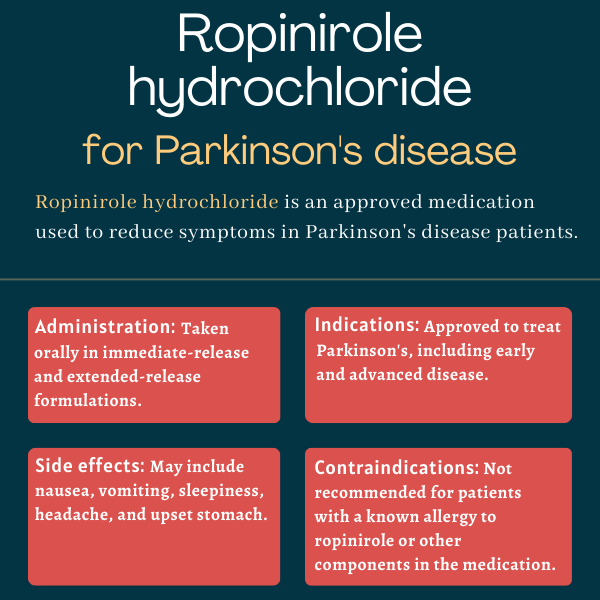Ropinirole hydrochloride for Parkinson’s disease
What is ropinirole for Parkinson’s disease?
Ropinirole hydrochloride is an approved oral therapy used to ease symptoms in people with Parkinson’s disease. The therapy is available only as a generic medication, in either immediate-release or extended-release tablet formulations.
These formulations were originally sold in the U.S. under the brand names Requip and Requip XL by GlaxoSmithKline. However, the company decided in 2019 to stop its distribution in the U.S. due to a decrease in patient demand, primarily attributed to the widespread availability of multiple generic alternatives of ropinirole.
The immediate-release formulation of ropinirole also is approved for the treatment of moderate to severe restless legs syndrome, a condition that causes discomfort in the legs and a strong urge to move the legs.
Therapy snapshot
| Brand Name: | Available as a generic medication only |
| Chemical Name: | Ropinirole hydrochloride |
| Usage: | Used to ease symptoms of Parkinson’s disease |
| Administration: | Immediate-release and extended-release oral tablets |
How does ropinirole work?
Parkinson’s disease is a neurodegenerative disorder in which nerve cells that produce dopamine — a chemical messenger that sends signals between brain cells — slowly die. Dopamine is essential to send messages to coordinate movement, and decreasing levels of this molecule result in a progressive loss of control over movement and various other symptoms.
Ropinirole is a dopamine agonist, meaning it has similar properties to dopamine and can mimic some of its functions in the brain. Therefore, it can act as a substitute for the decreasing amounts of dopamine in the brain of Parkinson’s patients.
The therapy also is expected to reduce off episodes in Parkinson’s patients taking standard levodopa-based treatments, which provide the brain with raw material for making dopamine. Off episodes are periods when levodopa treatments stop working and motor symptoms return before another dose can be taken.
Who can take ropinirole?
The immediate release formulation of ropinirole, then called Requip, was approved by the U.S. Food and Drug Administration (FDA) in 1997 to treat people with Parkinson’s disease. The first generic versions of this formulation gained approval in 2008.
The extended-release formulation also was approved in 2008 for the same indication, and generics became available in 2012.
Who should not take ropinirole?
Both formulations of ropinirole are not recommended for people with a known allergy to the active ingredient or any other components in the therapy.
The treatment also should not be taken by patients with a major psychotic disorder, as it can increase the risk of a psychosis exacerbation.
How is ropinirole administered in Parkinson’s?
Ropinirole immediate-release and extended-release formulations are available as film-coated tablets that come in different strengths.
For each formulation, tablets of different strengths are usually available in distinct colors and with specific characters that help distinguish the multiple doses available. The specific characteristics of each tablet, however, may vary depending on the company selling the generic medication.
Seven strengths are available for the immediate-release formulation:
- 0.25 mg
- 0.5 mg
- 1 mg
- 2 mg
- 3 mg
- 4 mg
- 5 mg.
Five strengths are available for the extended-release formulation:
- 2 mg
- 4 mg
- 6 mg
- 8 mg
- 12 mg.
The recommended starting dose of ropinirole immediate-release tablets for Parkinson’s patients is 0.25 mg taken three times daily. If necessary, this dose can be increased on a weekly basis up to a maximum recommended total daily dose of 24 mg per day, divided as doses of 8 mg three times daily.
For ropinirole extended-release tablets, the starting dose is 2 mg once daily for one to two weeks, which could be increased by 2 mg increments at weekly or longer intervals. While the maximum recommended dosage for ropinirole extended-release tablets is 24 mg, it is generally advised that individuals with advanced Parkinson’s disease should typically be prescribed daily doses of 8 mg or below. Similarly, patients in the early stages of Parkinson’s disease are typically recommended to maintain daily doses at 12 mg or lower.
Patients have the option to transition directly from immediate-release ropinirole to ropinirole extended-release tablets. To ensure a smooth switch, the initial dose of ropinirole extended-release tablets should closely correspond to the total daily dose of the immediate-release formulation.
For patients with kidney problems who are undergoing hemodialysis, the suggested initial dose of ropinirole varies based on the intended formulation. When using immediate-release tablets, it’s recommended patients start with 0.25 mg three times daily, while the extended formulation suggests a once-daily dose of 2 mg. Any further adjustments in dosage should be made considering the patient’s tolerance and the need for effectiveness.
The medication should be swallowed whole, and not split, crushed, or chewed. It can be taken with or without food.

Ropinirole in clinical trials
The efficacy of ropinirole was first demonstrated in three placebo-controlled trials that tested the immediate-release formulation in early and advanced stages of Parkinson’s disease. Two of the trials included patients in the early stages of the disease who were not using levodopa, while the other trial involved patients already receiving levodopa treatment.
The efficacy of ropinirole extended-release tablets for Parkinson’s was supported by two clinical trials in patients with both early and advanced disease. Two postmarketing clinical trials then provided additional evidence of the effectiveness of this formulation in patients with advanced and early Parkinson’s.
Trials in early Parkinson’s disease
Two trials evaluated ropinirole immediate-release tablets in individuals with early Parkinson’s. The first trial enrolled 63 patients who were receiving concurrent anti-Parkinson medications, excluding levodopa. The primary outcome measure was the proportion of patients who experienced a minimum 30% decrease in their Unified Parkinson’s Disease Rating Scale (UPDRS) motor score compared with the beginning of the study.
After 12 weeks, or about three months, a significantly greater number of patients (71%) treated with ropinirole tablets showed a positive response compared with those who had received a placebo (41%).
The second trial enrolled 241 participants and assessed changes in their UPDRS motor score over a six-month period. The ropinirole group showed an improvement in UPDRS scores — a 22% decrease — whereas those on the placebo showed a worsening of symptoms, as evidenced by a 4% increase in the UPDRS score. This difference was significant.
The EASE-PD Monotherapy trial was designed to assess if the extended-release formulation was at least as good as the immediate-release tablets in patients with early-stage Parkinson’s not taking levodopa or dopamine agonists for at least two weeks. Participants were randomly assigned to four treatment sequences, two of which started with the immediate-release tablets and used their titration schedule. The other two started with extended-release tablets and then switched to immediate-release ropinirole at different time points.
During the titration phase, all groups demonstrated similar improvements in UPDRS total motor scores from baseline, or the trial’s start, until completion. However, no significant differences were observed when switching between formulations, suggesting there was a therapeutic dosage equivalence between the immediate-release and extended-release formulations.
Trials in advanced Parkinson’s disease
A clinical trial investigated the immediate-release formulation in 149 advanced-stage Parkinson’s patients whose symptoms were not adequately controlled despite treatment with levodopa. Patients were randomly assigned to ropinirole or a placebo for six months, and could increase their dose until an optimal therapeutic response was reached.
The trial’s primary goal was to determine the proportion of responders, or patients who achieved a decrease of at least 20% in their levodopa dosage, as well as a 20% or greater reduction in the duration of off periods during time awake. Researchers also examined the average change in off time and in daily levodopa dosage compared with the beginning of the study.
After six months, there were significantly more responders in the ropinirole group (28%) than among those given a placebo (11%). Ropinirole treatment also resulted in much greater decreases in levodopa doses (19.4% vs. 3%), and in greater reductions in off time compared with the placebo (1.5 hours vs. 0.9 hours).
The extended-release formulation was investigated in the EASE-PD Adjunct study, a placebo-controlled trial that enrolled 393 people with advanced Parkinson’s. Participants were experiencing at least three hours daily of off time despite levodopa treatment, and were randomly assigned to ropinirole extended-release tablets or a placebo for six months.
The results showed that ropinirole significantly reduced the average duration of off time by 2.1 hours per day, compared with a reduction of 0.3 hours per day with the placebo. Importantly, a significant decrease in off time was observed as early as two weeks after starting treatment with a daily dose of 4 mg.
UPDRS motor scores also showed significant improvement with ropinirole compared with the placebo. After 24 weeks or about six months, more patients taking ropinirole were rated as “very much improved” or “much improved” according to the Clinical Global Impression-Improvement (CGI-I) scale, compared with those on the placebo. Additionally, patients on the extended-release tablets had a greater reduction in their levodopa dosage compared with those on the placebo.
Common side effects of ropinirole
The most common side effects of ropinirole immediate-release tablets among early Parkinson’s disease patients include:
- nausea and vomiting
- sleepiness
- dizziness and fainting
- fatigue, tiredness, and weakness
- viral infection
- leg swelling
- indigestion.
For patients with advanced Parkinson’s, the most frequently occurring side effects with immediate-release tablets include:
- dyskinesia, or uncontrolled sudden movements
- sleepiness
- nausea
- dizziness
- confusion
- hallucinations, or seeing or hearing things that are not real
- increased sweating
- headache.
In early Parkinson’s disease patients, the most commonly reported side effects in clinical trials testing extended-release tablets include:
- nausea
- sleepiness
- high blood pressure
- headache
- abdominal pain or discomfort
- dizziness
- constipation.
The most common side effects of ropinirole extended-release tablets in advanced Parkinson’s include:
- nausea
- dyskinesia
- dizziness
- hallucinations.
Falling asleep during daily activities
Ropinirole has the potential to induce sleepiness or drowsiness, and there have been reports of people falling asleep during daily activities while taking this treatment. It is important that healthcare providers evaluate any possible factors that could contribute to heightened sleepiness, such as the use of other medications, alcohol consumption, or existing sleep disorders, before treatment with ropinirole is started.
Patients who experience significant daytime sleepiness or fall asleep suddenly should consider discontinuing the treatment. If they choose to continue the medication, they should refrain from engaging in activities like driving that could pose a risk if they unexpectedly fall asleep.
Dyskinesia
Treatment with ropinirole may cause or exacerbate dyskinesias — uncontrolled, involuntary movements common in Parkinson’s disease — which can require a dosage reduction.
Low blood pressure upon standing
Ropinirole may reduce blood pressure and result in a condition called orthostatic hypotension. This is when dizziness or lightheadedness occurs when rising from sitting or lying down; it can lead to episodes of loss of consciousness (fainting). Patients should be carefully monitored for evidence of orthostatic hypotension, especially during dose escalation periods.
Hallucinations, psychosis, and impulse control
Ropinirole can impact patients’ mental health and lead to issues related to impulse control, such as gambling or excessive spending, binge eating, and heightened sexual urges. Individuals experiencing these urges may not perceive them as abnormal. If patients experience these complications, dose reduction or therapy discontinuation should be considered.
The treatment may cause hallucinations, in which patients see or hear things that are not real. Individuals taking the medication also may experience confusion, aggressive behavior, and psychotic behaviors. Ropinirole generally is not recommended for patients with a known psychotic disorder, as it may exacerbate psychotic symptoms.
Withdrawal problems
Symptoms such as high fever, apathy, stiff muscles, anxiety, depression, fatigue, insomnia, sweating, or pain have been reported following rapid dose reductions or sudden discontinuation of dopaminergic therapy, including ropinirole. As such, patients should be closely monitored during and after discontinuation of ropinirole.
Tissue scarring complications
Complications associated with tissue scarring — including fluid accumulation between the membranes that cover the lungs, thickening of those membranes, scar tissue in the lungs, as well as damage to the valves of the heart — have been observed in patients taking ropinirole. There is not enough evidence to prove a direct cause-and-effect relationship between ropinirole and these complications, but it is possible that the medication may have played a role in their occurrence.
High blood pressure and changes in heart rate
Blood pressure may increase while taking ropinirole extended-release tablets, potentially worsening hypertension. Dose adjustment may be required if blood pressure remains consistently high, and patients with cardiovascular disease should be aware of the possibility of significant changes in heart rate.
Use in pregnancy and breastfeeding
Ropinirole has not been well studied in patients who are pregnant or breastfeeding, but animal studies suggest the therapy may cause harm to a developing fetus and may be present in human milk. In addition, reduced lactation is expected with ropinirole treatment as it suppresses the secretion of prolactin, the hormone responsible for breast milk production.
Patients who are or plan to become pregnant, and those who are nursing or plan to breastfeed, should discuss this issue with their healthcare providers.
Parkinson’s News Today is strictly a news and information website about the disease. It does not provide medical advice, diagnosis or treatment. This content is not intended to be a substitute for professional medical advice, diagnosis, or treatment. Always seek the advice of your physician or another qualified health provider with any questions you may have regarding a medical condition. Never disregard professional medical advice or delay in seeking it because of something you have read on this website.
Recent Posts
- Immune T cell response may detect Parkinson’s before symptom onset
- Bezisterim clinical trial uses hybrid design to promote accessibility
- Parkinson’s advocacy groups call for ‘robustly funded, collaborative NIH’
- I may be overprotective, but it’s progress, not perfection
- Living with Parkinson’s reminds me what friends are for
FAQs about Ropinirole
The U.S. Food and Drug Administration first approved ropinirole immediate-release tablets more than a quarter century ago, in September 1997, to treat people with Parkinson’s disease. The extended-release formulation was approved in July 2008 for the same indication.
Animal studies suggest ropinirole may be harmful to a developing fetus. However, its effects on pregnant patients are unknown due to a lack of clinical data, so it is unclear whether the therapy can be safely used in this population. It is recommended that patients consult their doctor if they plan to become pregnant while taking ropinirole.
Some people taking ropinirole may experience extreme drowsiness or unexpected episodes of falling asleep during daily activities. It is advised that patients starting this treatment avoid driving or engaging in potentially dangerous activities until they understand how the medication affects them. If these adverse events occur, it is recommended that patients talk to their doctor.
Based on data from clinical trials, ropinirole induces significant reductions in off time in people with advanced Parkinson’s disease as early as two weeks after starting treatment. However, because the initial recommended dose of ropinirole may not work for everyone, some patients may require dose adjustments before experiencing the full benefits of the therapy.
While neither hair loss nor weight have been reported as side effects of ropinirole in clinical trials, dopamine agonists may increase the risk of developing compulsive behaviors such as binge eating, which may lead to weight gain. Reversible hair loss also was occasionally reported in patients receiving ropinirole treatment. Patients should talk with their healthcare team if they experience any unanticipated effects of treatment.
Related Articles

 Fact-checked by
Fact-checked by 







